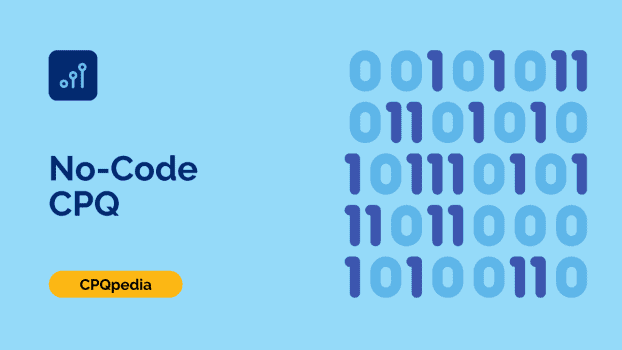What is No-Code CPQ?
No-code CPQ is a modern type of CPQ software that enables business users without specialized coding or IT skills to create, manage, and adjust complex product configuration rules and pricing strategies within the software. It achieves this through a graphical interface that lets users drag and drop components, define rules and conditions, and preview the end result in real time.
Sales teams use CPQ (configure, price, quote) software to configure products and services based on customer needs, calculate prices according to factors like volume and bundling, and generate accurate and optimized quotes for both the vendor and the customer.
To set this up, an admin needs to program hundreds of pricing rules and product configuration options according to company policy and product limitations. There is no visual interface for creating and managing a product catalog.
No-code software streamlines and simplifies these processes by eliminating the need for programming. Instead, it offers a selection of customizable templates and pre-built rules that users can modify to fit their specific business requirements.
Synonyms
- Visual CPQ
- Drag-and-drop CPQ
Demystifying No-Code Software
“No-code software” refers to platforms that allow users to create applications and systems through graphical user interfaces (GUIs) instead of traditional computer programming. These platforms provide all the necessary building blocks, which users can assemble like a puzzle to perform specific tasks and processes without writing code.
Core functionalities of no-code platforms typically include:
- Application design
- Workflow automation
- Data integration (e.g., CRM)
- Reporting and analytics
Of course, “no-code” doesn’t mean the code doesn’t exist. Everything a no-code platform can do has already been coded by developers. Each of its building blocks has pre-built code that non-programmers can customize, add, and remove to customize the application to their needs. The software’s capabilities are limited to what that pre-built code allows.
In the context of CPQ, this means users can design, implement, and manage their product catalog, pricing strategies, and quoting process through simple, user-friendly interfaces. But they can’t change the underlying code of the software itself.
Challenges of Traditional (Heavy Code) CPQ Implementation
When there’s a lot of coding involved, achieving a smooth CPQ implementation is tough. Coding requirements are prohibitive both in terms of cost and time.
This is because:
- It requires developers’ specialized skills that are both expensive to hire and keep on stand-by.
- It’s a long and complex process that involves a lot of debugging, testing, and reworking.
- It’s prone to human error, which could result in incorrect product configurations or pricing calculations.
- When coding for CPQ, developers have to account for future changes, even though it’s impossible to anticipate all future requirements.
- Every change to the company’s pricing strategy or product suite requires manual coding changes, leading to delays in addressing market changes.
These issues make code-based CPQ especially prohibitive for startups and SMBs. Besides the fact that companywide implementation could cost tens or hundreds of thousands of dollars, the inability to quickly test, execute, and change pricing/product strategies creates a tremendous competitive disadvantage.
Unveiling the Benefits of No-Code CPQ Software
Today, accessibility, user empowerment, and operational efficiency are key drivers of technology adoption in sales environments. The shift towards no-code CPQ solutions represents this broader trend in digital transformation.
Compared to traditional CPQ, its no-code counterpart is:
- Graphical and user-friendly
- Faster to implement and make changes
- Accessible to a wider range of users within an organization
- Cost-effective
- Agile and adaptable to changing needs
With no-code CPQ, companies achieve faster deployment times and reduce users’ learning curves. This leads to shorter sales cycles, an improved customer experience, and, ultimately, higher conversions and revenue growth.
It also makes data integration more scalable and affordable. It shortens the time to market for new products and pricing strategies. And it facilitates collaboration, communication, and transparency between different departments involved in customer-facing sales processes.
Exploring the Potential Disadvantages of No-Code CPQ
Although no-code CPQ platforms are particularly beneficial during the GTM phase, they might present challenges in the long run, especially as companies scale.
Some of these challenges include:
- Limited customization options. As mentioned earlier, no-code software’s capabilities are constrained by pre-built code. Enterprise companies with thousands of complicated pricing and product configurations will find this limiting.
- Data integration limitations. Although it’s fairly easy to integrate CRM and other internal systems via an API, no-code CPQ might not integrate well with external vendors and partners, which could limit the range of products and services a company can offer.
- Scalability constraints. Depending on the no-code CPQ platform’s sophistication (and extensibility beyond no-code features), it could be challenging to scale operations as the company grows and its needs evolve.
These potential issues with no-code vs. low-code or customizable software make it one of the most important considerations when evaluating CPQ for SMB vs. enterprise needs.
Smaller companies benefit from the cost-effectiveness and agility of no-code software because they need to make frequent, rapid changes. Enterprises with complex (yet well-defined) processes need the opposite. So, they find the higher upfront costs and inherent complexity to be well worth it in the long run.
Examples of No-Code or Low-Code CPQ Solutions
Between CPQ implementation and ongoing maintenance costs, code-dependent software simply doesn’t make sense for most companies. That’s why no-code (or low-code) functionality is one of the core features of user-friendly CPQ.
Let’s take a look at some of today’s best no-code and low-code CPQ systems:
DealHub CPQ
DealHub CPQ is a comprehensive sales engagement platform that simplifies the quoting process for complex deals. It’s designed to be user-friendly — sales and ops teams can fully implement and maintain it with absolutely zero code or extensive IT resources. Implementation only takes a few weeks, on average.
Features include:
- Complex pricing and product rules configuration
- The DealHub Guided Selling Playbook
- Multi-dimensional pricing models (e.g., tiered and usage-based pricing)
- Automated parallel approval workflows
- Dynamic quote and proposal generation
- Buyer engagement insights
- Native integration with popular CRM systems like Salesforce, Microsoft Dynamics 365, Freshworks, HubSpot, and SugarCRM.
Besides its no-code capabilities, DealHub offers DealRoom, a digital sales room that centralizes all relevant sales data, content, and communication for each deal. It also offers features for subscription management, billing, and contract lifecycle management.
The suite of no-code tools DealHub offers makes it the best tool for SaaS quoting.
PandaDoc
PandaDoc CPQ is designed to enhance the sales process by making quote generation both smart and efficient. It caters especially to small and medium-sized businesses with its user-friendly platform for creating, sending, tracking, and signing quotes, proposals, and contracts.
Features include:
- Customizable document templates
- Content library with reusable blocks
- Approval workflows and e-signatures
- Advanced pricing rules for products and subscriptions
- E-signature
- Payment integrations
PandaDoc’s strong suit is its simple, interactive UI. Customers and sales reps can interact with quotes, adding optional items and upgrades directly, which enhances the buying and selling experience. It doesn’t have the most advanced quoting capabilities, which is why it’s best for small and mid-sized companies that don’t have remarkably complex quoting needs.
Vendavo
Vendavo CPQ is a robust B2B sales platform for global-scale organizations. It streamlines the CPQ process by leveraging AI to provide real-time pricing, optimal quote configurations, and detailed analytics. It’s a low-code application that requires some technical skills to implement and maintain.
Features include:
- Visual product configuration
- Guided selling and complex configurations
- Sophisticated, AI-powered pricing and profit optimization
- Branded proposal generation
- Quote and contract management
- Intuitive user dashboards and real-time analytics
- At-risk customer alerts
Vendavo’s low-code capabilities make it a powerful tool for multi-level pricing and product configuration, which is essential for multinational enterprises with diverse product libraries.
HubSpot
HubSpot CPQ offers a seamless and integrated solution for sales teams, built atop the HubSpot CRM platform. If you use HubSpot to run your B2B sales and marketing operations, HubSpot CPQ is a natural extension of that platform. In addition to being a no-code system, it’s free for HubSpot users.
Features include:
- Customizable product catalog and price book
- Customized quoting workflows
- Multi-currency support
- Branded proposals and quotes with digital signatures
- Native, in-quote payment solutions
As a free tool, it has its limitations. However, more advanced features are accessible through the paid tiers, which include Starter, Professional, and Enterprise editions. Whether you’re an agency owner, project-based business, or software vendor, it’s an excellent CPQ solution that requires zero coding skills.
MonetizeNow
MonetizeNow CPQ is a versatile platform designed specifically for B2B SaaS businesses. It integrates comprehensive CPQ, billing, and usage capabilities to streamline the entire quote-to-cash process.
Features include:
- Support for subscriptions, one-time charges, and usage-based pricing
- Rep-facing and self-service quoting
- Quote tracking
- Revenue recognition and invoice management automation
- Advanced usage metering
- Subscriber lifecycle management
MonetizeNow’s all-in-one no-code platform is ideal for SaaS businesses and IT service providers. Its purpose-built features for software sales and billing make it a one-stop shop for managing complex recurring revenue models.
FAQs
No-code CPQ solutions are generally secure, but, like any software, their security depends on the specific platform and its implementation. It’s essential to choose a reputable provider with security protocols in place to protect sensitive sales data and ensure compliance with regulations in your industry and areas of operation.
No-code CPQ can integrate with CRM systems without the need for significant coding or IT involvement. The platforms typically provide seamless integration options with popular CRMs like Salesforce, HubSpot, and Microsoft Dynamics. However, larger-scale integration projects will require some level of technical expertise and integration options vary by platform.

Andrew is a professional copywriter with expertise in creating content focused on business-to-business (B2B) software. He conducts research and produces articles that provide valuable insights and information to his readers.

